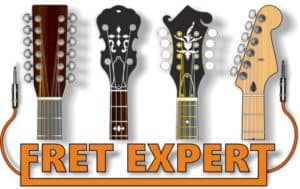To help you weave your way through the often confusing maze of different banjos, I’ll detail some of the key differences and similarities in the following article.
Hopefully, it will give you a basic understanding of what’s available and which is likely to suit you and your musical aspirations.
Covered in this Article:
Banjo (Bluegrass or 5-String)
Also Known As: 5-String banjo, bluegrass banjo or ‘G’ Banjo
Standard Tuning: Open G (G4 D3 G3 B3 D4)
Alternative Tunings: Standard C (G4 C3 G3 B3 D4), Double C (G4 C3 G3 C4 D4), Sawmill (G4 D3 G3 C4 D4)
Arguably, the 5-string is the instrument people would most associate with a typical image of a banjo. It’s also by far the most popular model, used in every genre of music from bluegrass to indie folk because of its versatility.
What separates it from all the other models is the addition of the fifth drone string which is situated to the left of the fifth fret. The string gauge for both the first and fifth strings is generally the same. You can tune the fifth drone string by fretting on the fifth fret of the first string.
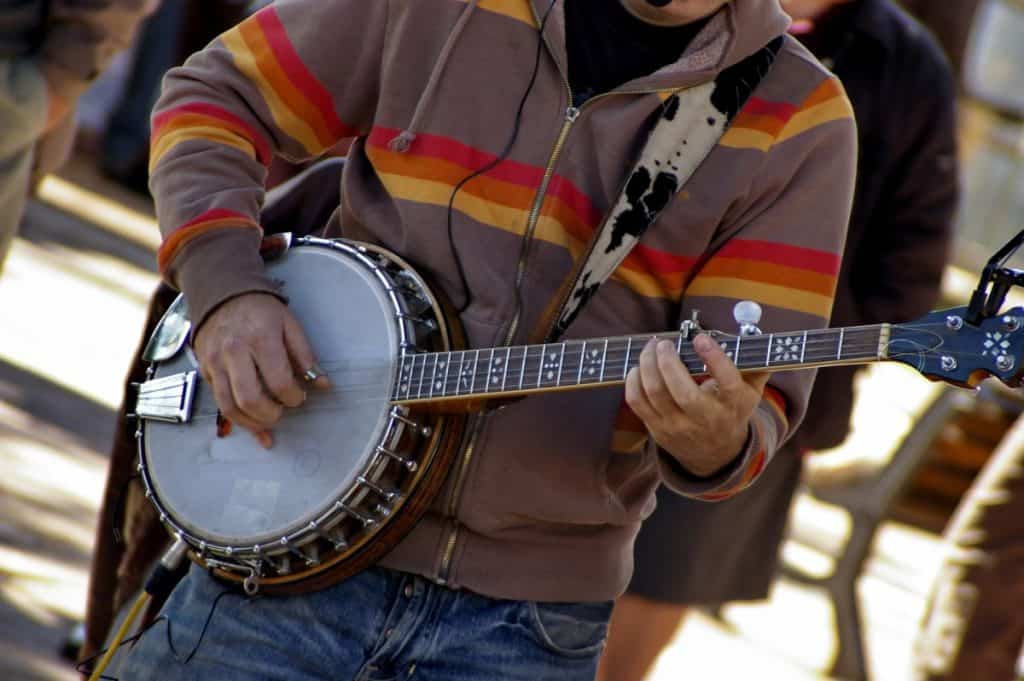
Open Back vs Resonator Banjos
The basic 5-string design comes in two distinct configurations:
The open-back model which is more suited to folk and old-time traditional music, and the resonator models, which tend to be used within bluegrass.
There aren’t any hard and fast rules on this and cross-over does occur, but to generalize, if your interest lies in either of these areas and you want an authentic sound, those are your main options.
If you suffer from back issues, the resonator models are considerably heavier than their open back counterparts, so you may want to take that into consideration when acquiring an instrument.
The resonators are also a lot louder as the same suggests, so if you’re in a house with paper-thin walls, the open back model might be a better fit. You can also damp or mute the open back with a cushion, foam or other packing material if you need to reduce volume.
5-String Banjo Techniques and Styles
Technique-wise, the most popular style in bluegrass is referred to as Scruggs Style after Earl Scruggs, the leading exponent of the instrument. Other popular styles in bluegrass include Keith Style after the banjoist, Bill Keith and Reno or 3-String Style after Don Reno.
In contrast, different methods are used again within the open-back old-time and folk repertoire, called Clawhammer and Frailing. Some make a distinction between the two, but they share many of the same ingredients.
If you want to see the varying 5-string techniques in action there are numerous videos on YouTube offering free tutorials to get you started.
A long scale 5-string variant originally used by folk singer-songwriter Pete Seeger is also available as a specialist instrument. The Seeger banjo is tuned E4 B2 E3 G#3 B3.
For those with deep pockets, electric banjos are also available. These are generally quite expensive, but ideal for recording or live work if you don’t want to fuss with tricky microphone set-ups or use separate pickups. And yes… they do still sound like banjos!
For players who do a lot of key changes on the 5-string, a unique type of banjo capo is a useful addition. Unlike a regular capo, this is permanently screwed onto the neck underneath the 5th string tuning peg (a job probably best left to a guitar or banjo technician if you aren’t accustomed to this type of work).
Some players prefer to use a much simpler method of using tiny model railroad spikes tapped into the fingerboard to wrap the string around at given intervals (quite often on the 7th, 8th, 9th, and 10th frets). If you feel brave enough to install your own spikes, take a look at the following video:
At the opposite end of the spectrum, a short scale 5-string was used from the late 1900s into the jazz age (1930s), called the Banjeurine. This was tuned a fourth higher than G tuning (C5 G3 C4 E4 G4).
Notable 5-String Banjo players:
- Earl Scruggs
- Béla Fleck
- Tony Trischka
- Don Reno
- Steve Martin (the actor and comedian)
- Jerry Garcia (Grateful Dead)
- Ralph Stanley
- Winston Marshall (Mumford & Sons)
- Bernie Leadon (The Eagles)
- Joey Haines (Bear’s Den)
- Pete Seeger
- Dolly Parton.
What’s the Difference Between a Banjo and a Banjo Ukulele?
For the uninitiated, the banjo and the banjo ukulele look very similar at first glance. Both have a circular banjo head reminiscent of a drum that is tightened over a resonating chamber called the pot.
There are other similarities between the two, construction-wise, but equally, the two instruments diverge quite significantly both in playing style and from a tuning point of view.
The term banjo is also an umbrella term covering anything with the above basic characteristics. So not only do the banjo and banjo ukulele differ, there are also several different standard banjo configurations. The banjo is described above, and the banjo uke is below:
Banjo Ukulele (Banjolele or Ukulele-Banjo)
Also Known As: Banjolele or ukulele banjo
Standard Tuning: G4 C4 E4 A4 (C or C6) or G3 C4 E4 A4 (low G tuning).
Alternative tuning: A4 D4 F#4 B4 (D or D6) or A3 D4 F#4 B4 (low A tuning) and DGBE (baritone, G or G6).
The banjo uke is a very different animal to the 5-string instrument and is the only type of banjo to feature nylon or composite strings. All the others use metallic strings made from a variety of metals including: stainless steel, nickel plated steel and phosphor bronze.
This makes the banjo uke a lot friendlier on the fingers, particularly for children. The smaller size also makes it an attractive choice both in terms of comfort and transportability.
If you want to delve deeply into more complex playing techniques used by the likes of George Formby, it can be taken to a much more difficult level. If on the other hand, if you want to strum a few chords like you might on its identical wooden sibling, the ukulele, the banjo uke is a great little instrument for doing that as well.
A word of warning; not all banjo ukes are equal in terms of quality. There are some decent entry level models, but equally there are some very badly intonated stinkers out there, so try them out if you can or at the very least watch a few review videos.
Like the ukulele, you can use either re-entrant tuning (the famous ‘my dog has fleas’ tuning) or opt for the low ‘G’. Both are tuned GCEA, but re-entrant features a ‘G’ one octave above.
If you want a shallower learning curve, then the banjo uke is the better option and it will also allow you to switch between it and the regular ukulele (soprano, concert and tenor models).
The baritone uke is tuned lower and although it uses the same sort of chord shapes, they’re in a different key, more akin to the first four strings of a guitar. There are also some baritone banjo ukes, but these tend to be harder to find and cost a lot more than regular models.
If you want to test yourself technically, there was no better player than George Formby, who was unfortunately pigeon-holed as a comedic actor and singer of novelty songs. A technically brilliant player who still has a large following today.
Notable banjo ukulele players:
- George Formby
- Roy Smeck
- Arthur Godfrey
- Billy Scott
- Tessie O’Shea.
Plectrum Banjo (4-String Banjo)
Also Known As: 4-string banjo
Standard tuning: C3 G3 B3 D4
Alternative tuning: D3 G3 B3 E4 (Chicago)
The plectrum banjo as the name suggests is played with a plectrum or pick, rather than fingers or finger and thumb picks.
Although standard tuning is CGBD, a number of players prefer DGBE as it makes transition from a guitar a much more straightforward process. It’s also been used quite a lot in musical theater because of the similarity to guitar tuning.
This has meant the production doesn’t have to employ a specialist plectrum player, who will often double on guitar.
The plectrum banjo is also a popular choice for players who use a lot of chordal structures, rather than fingerpicking, as used on the 5-string banjo.
It’s also pitched lower than the tenor banjo and was popular on earlier jazz recordings. The plectrum has also found favor within folk music circles as an alternative to the 5-string and tenor.
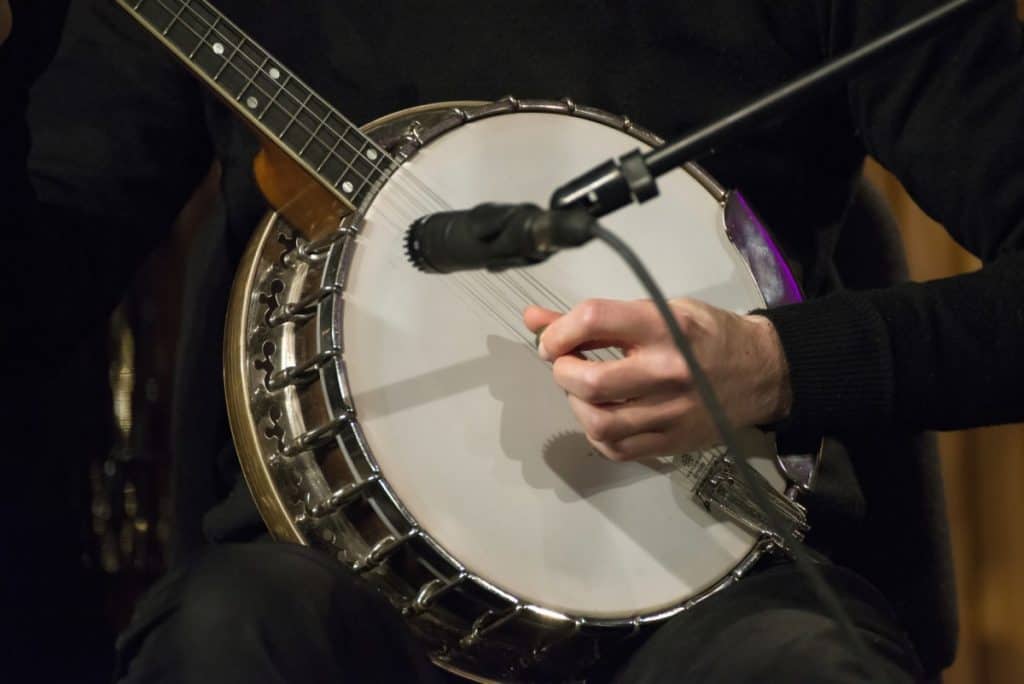
Tenor Banjo (Jazz Banjo / Irish Tenor Banjo)
Also Known As: Jazz banjo or Irish tenor banjo
Standard tuning: C3 G3 D4 A4 (jazz and Dixieland) and G2 D3 A3 E4 (Irish)
The tenor banjo has a much shorter scale in comparison to the 5-string and plectrum models and generally features around 17-19 frets.
The tuning is in true fifths, so the next string is always seven frets up from the last (going from low to high). C to G, G to D and so on. The instrument originally found its home in early jazz bands and is still very popular within trad and Dixieland circles today.
It’s also become the go-to instrument within Irish folk music and ceili (kay-lee) bands. The tenor is probably the second most popular banjo behind the 5-string.
Notable Tenor Banjo Players:
- Eddie Peabody
- Roy Smeck
- Elmer Snowden
- Don Vappie
- Harry Reser
- Perry Bechtel
- Buddy Wachter
- Barney McKenna (The Dubliners),
- Howard Alden
- Narvin Kimball
- Manny Sayles
- Gerry O’Connor
- Jem Finer (The Pogues).
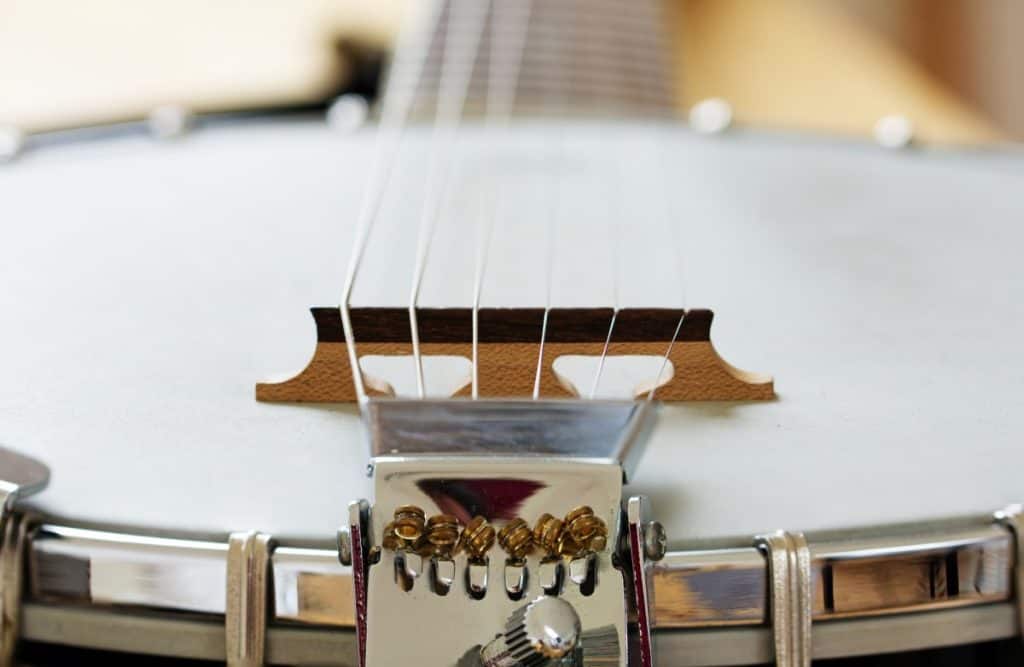
6-String Banjo (Guitar Banjo)
Also Known As: Guitar banjo
Standard Tuning: E2 A2 D3 G3 B3 E4
Alternative Tunings: Drop D (D2 A2 D3 G3 B3 E4)
The 6-string or guitar banjo often falls victim to a degree of snobbery from within the regular banjo fraternity. The association with the guitar has led to charges of it only being a novelty instrument for players who can’t be bothered to learn the 5-string, plectrum or tenor.
Of course it’s true that the transition from guitar to banjo is made considerably easier, when you don’t have to learn a new set of fingerings or master a different technique for that matter, but it is still a fantastic instrument in its own right.
It’s also great to add different colorings to pieces of music if you can’t face re-learning everything from scratch – it still sounds like a banjo! Some models have larger bodies or pots than others, leading to a much fuller more rounded sound.
Notable 6-string banjo players:
- Johnny St. Cyr (King Oliver’s Creole Jazz Band)
- Django Reinhardt
- Neil Young
- Doc Watson
- Keith Urban
- Joe Satriani
- Taj Mahal
- Danny Barker
- Papa Charlie Jackson
- David Hidalgo
- Rod Stewart
- Larry Lalonde
- Dave Day (The Monks)
- Clancy Hayes
Mandolin Banjo (Bandoline)
Also Known As: Banjolin, banjoline, bandoline and banjourine.
Standard tuning: G3 D4 A4 E5
Much like the banjo ukulele mirrors the standard uke, so the mandolin banjo gives the mandolin player a different sounding option without the need to re-learn the fingerboard layout and a whole new set of chords.
For me, it’s more of an acquired taste than any of the other banjos, but still has its uses if you’re looking for something a little different.
For some reason you often seem to see mandolin banjos gathering dust in junk shops or as an unwanted family heirloom in a garage sale. Again, probably unfair pigeonholing of a unique instrument.
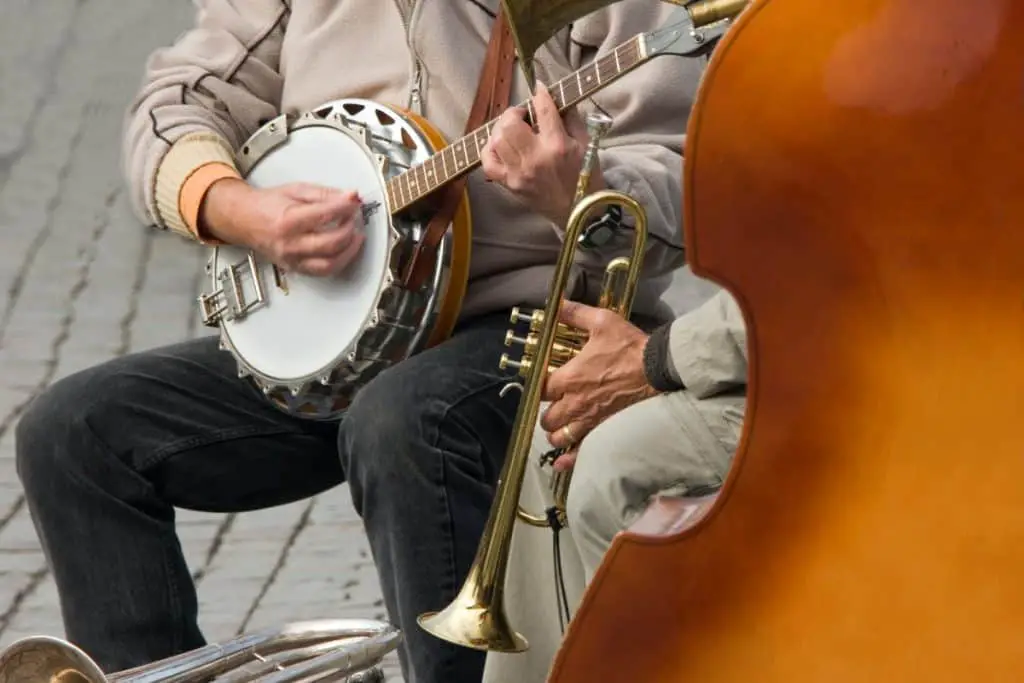
Cello Banjo
Also Known As: Banjo cello
Standard tuning: C2 G2 D3 A3
5-String tuning: A3 E2 A2 C#3 E3 or G3 D2 G2 B2 D3
The cello banjo unremarkably features the same tuning as the cello and was a popular instrument within early banjo orchestras from the early part of the 20th century.
The Gold Tone banjo company also produce a 5-string cello model and has revived this interesting instrument over recent years.
Notable Cello Banjo Players:
Marcy Marxer and Abigail Washburn.
Bass Banjo & 3-String Contrabass Banjo
Also Known As: bassjo
Standard tuning: E1 A1 D2 G2 (bass) and E1 A1 D2 (3-string contrabass)
The bass banjo is a fairly rare beast these days, but in the early part of last century was used in banjo orchestras or to replace a traditional upright double bass. It was also played in the same fashion, with the instrument standing vertically, rather than horizontally.
The tuning like the upright, bass guitar, and ukulele u-bass is EADG, an octave below the last four strings of a guitar. A 3-string contrabass variant also exists, but without the standard first ‘G’ string.
Modern bass banjos are a lot smaller and are played like a bass guitar. Like many instruments that have fallen out of favor over the years, the bass banjo is undergoing something of mini-revival.
Banjo-Bouzouki
Also Known As: banzouki
Standard Tuning: Open G (G4 D3 G3 B3 D4)
Alternative Tunings: Standard C (G4 C3 G3 B3 D4), Double C (G4 C3 G3 C4 D4), Sawmill (G4 D3 G3 C4 D4)
Basically, a modern hybrid instrument with the tuning and neck of a 5-string banjo and the body of an Irish bouzouki.
An interesting choice for a 5-string player wanting to add something a bit different tone-wise. The banzouki adds much more of a folky woody quality to your musical arsenal.
Overall, I hope this helps you to distinguish between each of the fascinating types of banjo out there!
